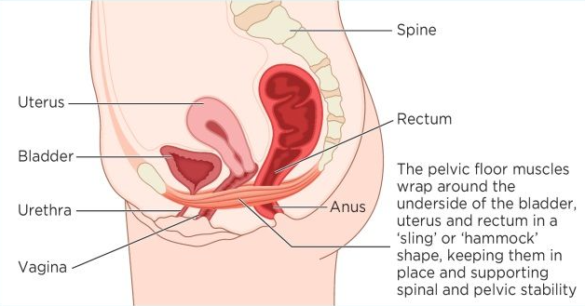‘Pelvic Floor’ a term that’s thrown around a lot. You might hear your Pilates instructor mention it, your friends talk about it, or your doctor say you may need to strengthen it.
But what does the pelvic floor really do? Why do we need to know about it? And how can we treat it when it stops working for us?
We spoke to one of iMove Physiotherapy’s qualified women’s health physiotherapists, Emma Lyon, to find out the answers to all of your FAQ about the pelvic floor.
Where is the pelvic floor?
Your pelvic floor is a group of muscles and fascia that form a ‘sling’ from your tailbone to your pubic bone.

What is the function of the pelvic floor?
Your pelvic floor acts to support your bowel and bladder, so that you’re able to control the release of urine, faeces and wind.
A pelvic floor contraction will tighten the opening of your urethra and anus, allowing you to ‘hold on’ until an appropriate time.
Your vagina also passes through the pelvic floor muscles, therefore it provides a role in sexual function.

Why does the strength of our pelvic weaken over time?
Pelvic floor weakness can occur as a result of a number of causes;
– Pregnancy – the weight of a baby adds pressure on your pelvic floor for months and can cause weakness over time
– Vaginal birth – the trauma of a vaginal delivery can damage and weaken the pelvic floor muscles
– Repetitive heavy lifting or excessive coughing – can place strain on the pelvic floor
– Being overweight – when you are overweight, excess weight sits on top of the pelvic floor, forcing it downward
– Chronic constipation – difficulty passing a bowel movement means straining and increases pressure on the pelvic floor
When pelvic floor dysfunction occurs, what do we see happen?
When Pelvic floor dysfunction occurs, it can result in conditions such as;
– Stress Incontinence (leakage or accidents), particularly during physical activity
– Prolapse of the pelvic organs
– Pain in the pelvis, genital area or even lower back
– Pain during sex
– Pelvic spasms
– A constant need to urinate

How can women maintain a strong pelvic floor?
Learning how to control your pelvic floor can aid in preventing pelvic floor dysfunction and managing incontinence (which can be caused by poor control and/or strength of your pelvic floor muscles.) .
Pelvic floor muscle training has been shown across many studies to cure stress urinary incontinence (SUI) in 50% of women and improve symptoms of leaking in 75% of women. These studies involved women doing pelvic floor muscle exercises every day for three months.
On the other hand, issues can also arise from having an ‘overactive’ pelvic floor.
Physios can help identify some of these causes, and if they are specially trained – a women’s health Physio – can conduct a thorough pelvic floor assessment and can offer specific advice whilst also providing treatment.
When done incorrectly, pelvic floor exercises are pointless, but our physios can help you identify the muscles that you need to be working and give you the techniques to perform correct and effective pelvic muscle training, which may help you to avoid incontinence and pelvic floor dysfunction.
Who can assist with pelvic floor concerns?
Women’s health physiotherapists have obtained post-grad qualifications in pelvic floor muscle training and are best placed to offer you advice and a tailored treatment plan to help address your specific concerns.
If your pelvic floor is giving you any cause for concern, make an appointment to speak to one of our iMove Physios today.
How do you book in to visit a Physio?
Simply visit the iMove website to make your appointment now.
